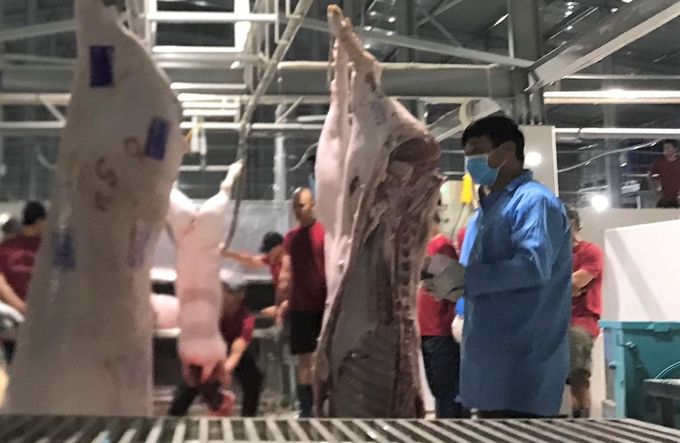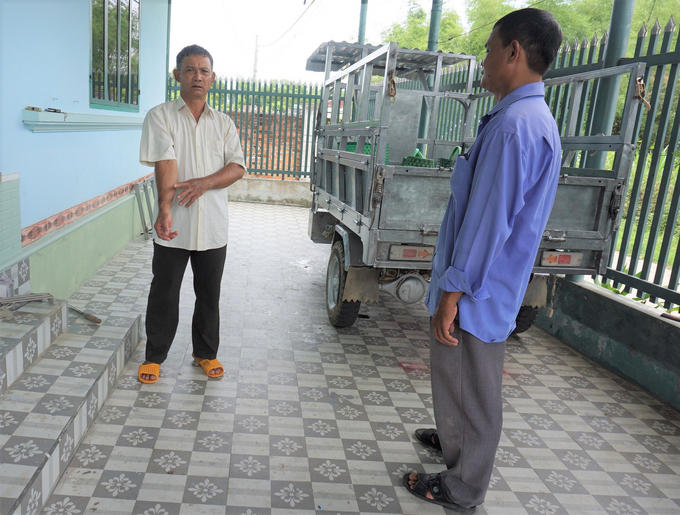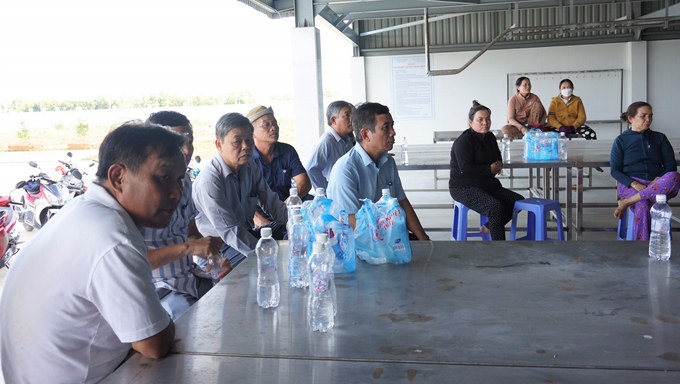November 24, 2025 | 16:42 GMT +7
November 24, 2025 | 16:42 GMT +7
Hotline: 0913.378.918
November 24, 2025 | 16:42 GMT +7
Hotline: 0913.378.918
Quy Nhon Food Production and Processing Co., Ltd has recently put into operation the slaughter line in Nhon An commune (An Nhon town, Binh Dinh). The company’s factory serves livestock and poultry slaughtering for hundreds of small slaughter households in An Nhon town and 5 northern communes of Tuy Phuoc district.
Since its first days of operation, the Nhon An centralized slaughter factory has received registration from 100 households, working on over 300 pigs per day. The factory utilizes 3 pig slaughter lines and 2 poultry slaughter lines so that the small slaughter households can supply the products to markets early. As for their evaluation, the slaughter process is fast and guaranteed, and products are strictly controlled in terms of quality before release for consumption, so they meet food hygiene and safety requirements.

The first day the Nhon An centralized animal slaughter factory (An Nhon town, Binh Dinh) came into operation. Photo: V.D.T.
“In the past, my family slaughtered 2 - 3 pigs at home every day. We mainly sold them to customers at the afternoon market. However, when the State issued a policy of moving small slaughterhouses into one centralized slaughterhouse, we changed the slaughter schedule to 4-5 am to serve the needs of customers while making sure we follow the State's policy,” said Nguyen Van Hung, head of a slaughter household in Phuoc Hung commune (Tuy Phuoc district).
According to Huynh Ngoc Diep, Director of Binh Dinh Sub-department of Livestock Production and Animal Health, to thoroughly prepare for the relocation of small slaughterhouses to the centralized slaughterhouse, from June 13, the working group of the local agricultural sector continuously organizes inspections of each slaughterhouse, giving instructions and requiring households to comply with bringing livestock into the centralized slaughterhouse. As a result, meat products sold at markets in An Nhon all have slaughter control marks.

Small slaughter households purchase vehicles to transport livestock to the centralized slaughterhouse. Photo: V.D.T.
Bui Tan Loc, Vice Chairman of the People's Committee of Binh Dinh ward (An Nhon town), said that this locality has 14 households bringing pigs to slaughter at the factory. Among the total of 74 pigs, some households registered 10 - 20 pigs at a time. Regarding small unregistered slaughter households, the ward authorities continuously check to avoid cases of clandestine slaughtering at home.
“An Nhon town used to have 115 small households slaughtering livestock and poultry interspersed in residential areas. When the Nhon An centralized animal slaughter factory was put into operation, 95 households decided to collaborate. There are still some problems at first, but we will continue to discuss with the households and find solutions. Their compliance with regulation right from the early stages is a positive signal. I believe everything will gradually be put in order," said Phan Thanh Hoa, Head of the Economic Department of An Nhon town.

Small slaughter households in 5 northern communes of Tuy Phuoc district (Binh Dinh) had a meeting at the Nhon An centralized animal slaughter factory before putting it into operation. Photo: V.D.T.
Muoi My, head of a slaughter household in Binh Dinh ward, also mentioned the problems he had during the factory’s early stage of operation. “I registered to slaughter 2 pigs/day, the factory arranged a cage just enough for 2 pigs to stand. However, when the farmer asked to sell the pigs, he sold the entire pen of 10 pigs, forcing me to buy them all instead of just 1 - 2 pigs. I don't know where to keep the other 8 to gradually slaughter them. Meanwhile, the slaughterhouse at home has been completely destroyed, so there is no more room to lock the other pigs up. I hope the factory will look into this matter and quickly come up with a solution”.
To meet the requirements of localities, Binh Dinh Sub-department of Livestock Production and Animal Health will mobilize 10 veterinary officers to the factory to carry out slaughter control and veterinary hygiene inspection, ensuring that cattle are thoroughly checked before, during and after slaughter.
“The province's interdisciplinary working group chaired by the Department of Agriculture and Rural Development will coordinate with relevant units to regularly monitor the slaughter situation from residential areas to markets so that meat products sold are guaranteed in terms of food safety and hygiene. Slaughter households that are lazy and do not comply with bringing cattle to the centralized slaughter factory will be penalized according to regulations", said Huynh Ngoc Diep, Director of Binh Dinh Sub-department of Livestock Production and Animal Health.
Translated by Samuel Pham
/2025/11/22/4018-4-213342_747.jpg)
(VAN) The Mekong Delta Agricultural Experts Club has attracted 143 experts and researchers to participate in providing consultancy and contributing initiatives to the development of one million hectares of high-quality rice.

(VAN) Ca Mau’s development of OCOP products opens a path to increasing cooperatives value, helping boost income, expand markets, and affirm collective economy's role.

(VAN) Turning seemingly ordinary coconut shells into unique jewelry and artwork, Nguyen Bang Nhi spreads the value of local culture through her brand, Cocohand.

(VAN) Results from the Sustainable Durian Model Project in Dak Lak have confirmed the critical role of Yara Viet Nam in transferring advanced nutritional solutions to farmers.

(VAN) In Tuyen Quang province, livestock farmers have introduced effective models and innovative practices that significantly strengthen African Swine Fever prevention and control efforts.

(VAN) This is the study conducted by IRRI and Can Tho University on the rice straw value chain in Mekong Delta showing an economic potential of more than 6.6 trillion VND/year.

(VAN) By participating in cooperative economics, many farmers in Tay Ninh have overcome hardship, mastered clean dragon fruit cultivation techniques.